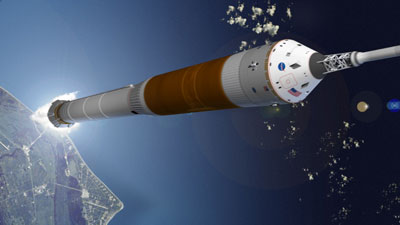Science versus human exploration: lessons from the seventiesby Taylor Dinerman
|
| Without a solid program for people, the robots might very well find that they have few reliable political supporters. Space science has, for decades had access to generous government funding due to its association with the idea that someday we will pioneer the space frontier. |
This should have been expected, since The Planetary Society is an organization whose priority is to support science. For them human exploration, and the general concept of humans moving out to settle the solar system, is at best a very low priority. In spite of the presence of several astronauts, such as Buzz Aldrin and Franklin Chang-Diaz, in the upper reaches of the organization, the goals of the organization are to study the solar system and the universe beyond rather than to move out into it. The best evidence for this was in their executive director’s statement in a recent Space News op-ed that, “One of the ironies of the current budget debate is that the word ‘exploration’ has been hijacked to mean ‘human spaceflight’.”
There is a good case that human spaceflight needs robotic explorers as precursors to human space travel. Even where space science has little or nothing to do with feasible manned expeditions, such as the mission to Jupiter’s moon Europa, it is still valuable as part of the effort to map the solar system. However, without a solid program for people, the robots might very well find that they have few reliable political supporters. Space science has, for decades had access to generous government funding due to its association with the idea that someday we will pioneer the space frontier. Otherwise it would be subject to the same pressures as other kinds of hard science.
Look at what happed to America’s particle physics efforts when, in 1993, the Superconducting Supercollider (SSC) project was canceled by Congress. This was an objective lesson of what can happen when scientists lose their ability to muster a coalition in favor of their programs. In those days the New York Times and others were on a jihad against “big science”. The space station, which was on the same hit list as the SSC, came within a single vote in the House of being canceled. Whatever its flaws, the ISS has been a source of invaluable experience for both the space industry and for NASA and its partners, and without it, Bush would have been in no position to launch the Vision for Space Exploration in January 2004.
The space community should have learned that, in Ben Franklin’s words “We must all hang together or surely we will all hang separately.” Robotic exploration needs its human counterpart and vice versa. Former JPL director Bruce Murray, in his book Journey Into Space: The First Thirty Years of Space Exploration, explained that “The Apollo momentum that had powered a generation of virtuoso American Planetary first looks was fast dissipating.” The budgets for early work on the shuttle and for missions such as the Mariner-Jupiter-Saturn, which became the two Voyager spacecraft, were cut to the bone.
For the science community this was frustrating, but for fourteen astronauts it was deadly. There is no doubt that the lack of enough early funding for shuttle development in the 1970s has led to a vehicle whose problems are all too well known. Flaws that should have been recognized and dealt with in those years made the shuttle into a far more fragile and cantankerous system than the safe and reliable “DC-3 of Space” that had been promised.
Today, when the last shuttle flights are being launched, NASA is working to design and build the next generation of human exploration vehicles. The CEV and the Ares 1 and 5 launch vehicles must be properly funded at the early design stage so that, thirty years from now, space experts and space scientists are not making the same complaints and going to Congress with similar petitions. NASA certainly needs at least another billion to carry out anything like the program that had been planned for in 2004–2005.
| The space community should have learned that, in Ben Franklin’s words “We must all hang together or surely we will all hang separately.” Robotic exploration needs its human counterpart and vice versa. |
Senator Barbara Milkulski of Maryland has proposed that NASA get on the order of two billion dollars in “emergency” funding to make up for the money it has spent getting the shuttle operational once again. She points out that after the Challenger accident in 1986 NASA was given at least $2.5 billion to buy the Endeavour shuttle and to help fix the solid rocket boosters. She makes a good case, but it seems unlikely that in the current tight budget environment NASA could in fact get that much.
One hopes that the US Senate appropriators will be more generous than their House counterparts. NASA needs not only some extra money for space science, but also all the money it has asked for—and perhaps even more—to develop the new human exploration systems. If these parts of the Vision are supported now, then later in this decade new money for robotic exploration can be found. The space community should give Mike Griffin the benefit of the doubt for the next couple of years. He has a hard enough job to do; having to argue and reargue the case for the current budgetary balance is not something he should be expected to do right now.
If, after the CEV and the Ares programs are well underway, science is still being underfunded, that will be the time for everyone in the community to join together and raise hell. At this stage of the process, the best thing for everyone is to push Congress to give NASA the extra billion it needs, and then give the agency some breathing room.
